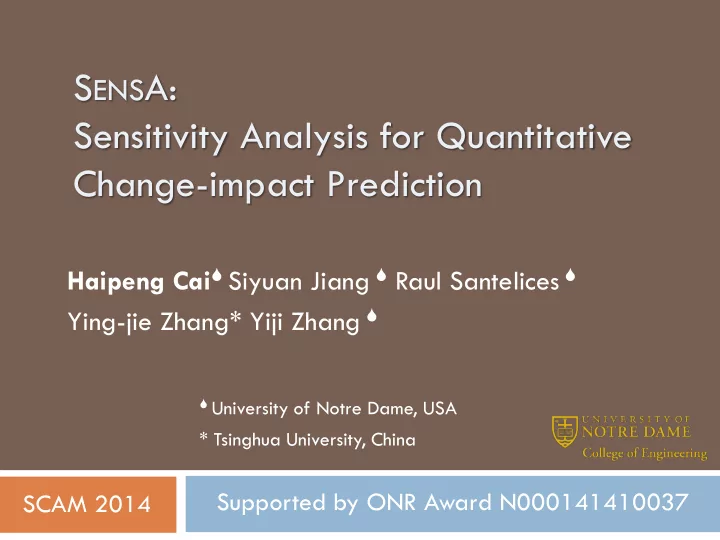

S ENS A: Sensitivity Analysis for Quantitative Change-impact Prediction Haipeng Cai Siyuan Jiang Raul Santelices Ying-jie Zhang* Yiji Zhang University of Notre Dame, USA * Tsinghua University, China Supported by ONR Award N000141410037 SCAM 2014
What we do 2 M1, M2, M3, M4, M5 M2 Candidate Change Locations Program base Predictive Dynamic Change-impact Analysis (CIA) Challenge 1: Coarse granularity (missing details) Predicted Impacts Challenge 2: Large size M1, M2, M3, M5 (incurring prohibitive costs)
What we do 3 M1, M2, M3, M4, M5 M2 Candidate Change Locations Program base Predictive Dynamic Change-impact Analysis (CIA) Challenge 1: Coarse granularity (missing details) Predicted Impacts Solution: statement-level analysis Challenge 2: Large size M1, M2, M3, M5 (incurring prohibitive costs) Solution: prioritize change impacts
Technique: overview 4 S ENS A Program Quantified P Impacts Execution Differencing Sensitivity Analysis Candidate Change Location Execution Instrumented Test Suite Histories P
Technique: sensitivity analysis 5 Candidate Change Location Static S ENS A Program Instrumenter Instrumented Program Modified Modified Modified Original …… Execution 1 Execution 2 Execution N Execution Runtime
Technique: execution differencing 6 // change Original Execution Modified Execution Statement Value Execution Statement Value Results (statements): 20 False 20 False History 6 6 True 6 False 7 11 -3 17 11 -3 12 -3 12 -3 7 - Impact set 17 False - (for statement 6) 4 -3 4 -3
How S ENS A works 7 //change Original Execution Multiple Modified Executions Statement Impact Frequency Execution Differencing 6 1 7 1 Impact Quantification 17 1 2 0 Only one modified Quantified execution for this 0 … Impact Set example 21 0
Subject programs and statistics 8 Subject Description Lines of Code Tests Changes Schedule1 Priority Scheduler 290 2,650 7 NanoXML XML parser 3,521 214 7 XML-Security Encryption library 22,361 92 7 Ant Java project build tool 44,862 205 7
Experimental methodology 9 program, test suite, statement S Actual change at S S ENS A Actual-impact computation Quantified impacts Actual impacts (ground truth) Impact-set Comparison Metrics computation
Experimental methodology 10 program, test suite, statement S Actual change at S S ENS A Actual-impact computation Quantified impacts Actual impacts (ground truth) Impact-set Comparison Only for evaluation: not parts of Metrics computation S ENS A
Experimental methodology 11 Metrics Effectiveness: inspection effort Percentage of worse-case inspection cost Cost: computation time Two variants: S ENS A-R AND , S ENS A-I NC Compare to: static slicing, dynamic slicing, ideal case Ideal case: best prediction possible use the actual impact set as the prediction result
Results: inspect effort 12 Ideal case static slicing dynamic slicing S ENS A-R AND S ENS A-I NC 60% 50% 40% 30% 20% 10% 0% Schedule1 NanoXML XML- Ant Overall security
Results: computation time 13 Subject Static analysis Instrumented run Post-processing 6 sec 4,757 sec 1,054 sec Schedule1 17 sec 773 sec 10 sec NanoXML 179 sec 343 sec 21 sec XML-Security 943 sec 439 sec 7 sec Ant Static analysis and post-processing cost little time Runtime cost dominates the total cost Come from multiple modified executions Can be greatly reduced by executing all modifications in parallel
Results: computation time 14 Subject Static analysis Instrumented run Post-processing 6 sec 4,757 sec 1,054 sec Schedule1 17 sec 773 sec 10 sec NanoXML 179 sec 343 sec 21 sec XML-Security 943 sec 439 sec 7 sec Ant Static analysis and post-processing cost little time Runtime cost dominates the total cost Come from multiple modified executions Highly Parallelizable Can be greatly reduced by executing all modifications in parallel
Conclusion 15 Contributions A novel approach to quantifying dependencies and, based on that, a quantitative dynamic impact prediction technique An empirical study of the new approach showing the significantly better effectiveness of the new approach than slicing, at reasonable costs Future Work To expand the study by including more subjects and more types of changes To apply the dependence-quantification approach to tasks other than impact analysis
Conclusion 16 Contributions A novel approach to quantifying dependencies and, based on that, a quantitative dynamic impact prediction technique An empirical study of the new approach showing the significantly better effectiveness of the new approach than slicing, at reasonable costs Future Work To expand the study by including more subjects and more types of changes To apply the dependence-quantification approach to tasks other than impact analysis
17
Controversial statements 18 Test suite augmentation is irrelevant to alleviating the limitation of dynamic analysis that the execute set used does not fully represent the program behavior. Quantitative dependence analysis is more effective than traditional non-quantified dependence analysis.
Recommend
More recommend